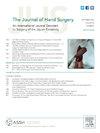臂丛神经产伤儿童肩部旋转在抬高基础上的变化
IF 2.1
2区 医学
Q2 ORTHOPEDICS
引用次数: 0
摘要
目的:肩部缺乏外旋在臂丛神经产伤的儿童中很常见。盂肱关节(GH)发育不良与逐渐丧失被动外旋功能有关。一些学者建议在手臂内收时测量外旋,而另一些学者则建议在手臂外展 90° 时进行测量。本研究的目的是比较主动和被动外旋和内旋的测量方法:方法:15 名臂丛神经先天性损伤的儿童在手臂内收和手臂外展约 90° 的情况下保持患臂最大程度的外旋和内旋。通过三维运动捕捉测量主动和被动旋转。计算肩胛胸(ST)内/外旋和GH内/外旋关节角度,并使用多变量单向重复测量方差分析进行比较:结果:主动或被动 ST 旋转在外展与内收的外旋关节角度上没有明显差异。盂肱外旋时,手臂外展与内收相比,主动和被动外旋均显著增加。主动与被动条件下的 ST 旋转没有差异,但被动条件下的所有 GH 旋转均明显增大:结论:外展和内收时的肩关节内旋/外旋不能互换。结论:外展和内收时的肩关节内旋/外旋不能互换,肩关节外旋和内旋的综合评估应包括内收和外展:对于臂丛神经先天性损伤的儿童,主动和被动的GH外旋在内收时都更大。因此,如果在外展时测量伽马外旋,可能会漏掉早期的伽马关节发育不良。此外,手臂位置的一致性对于长期比较也很重要。整个ST旋转能力都被用来进行最大程度的内旋和外旋,但整个GH被动运动范围并未被积极利用。这凸显了一个潜在的手术干预领域,以改善运动。本文章由计算机程序翻译,如有差异,请以英文原文为准。
Changes in Shoulder Rotation Based on Elevation in Children With Brachial Plexus Birth Injury
Purpose
Lack of shoulder external rotation is common in children with brachial plexus birth injuries. Development of glenohumeral (GH) dysplasia is associated with progressive loss of passive external rotation. Some authors recommend measuring external rotation with the arm adducted, whereas others recommend measurement with the arm in 90° of abduction. The purpose of this study was to compare active and passive external rotation and internal rotation measured in adduction versus abduction.
Methods
Fifteen children with brachial plexus birth injuries held their affected arms in maximal external and internal rotation with the arm adducted and the arm at approximately 90° of abduction. Active and passive rotations were measured with three-dimensional motion capture. Scapulothoracic (ST) internal/external rotation and GH internal/external rotation joint angles were calculated and compared using multivariable, one-way repeated measures analyses of variance.
Results
There were no significant differences for active or passive ST rotation in external rotation in adduction versus abduction. Glenohumeral external rotation was significantly increased with the arm in abduction compared with adduction both actively and passively. There were no differences in ST rotation in active versus passive conditions, but all GH rotations were significantly greater passively.
Conclusions
Shoulder internal/external rotation in abduction and adduction is not interchangeable. Comprehensive assessment of shoulder external and internal rotation should include both adduction and abduction.
Clinical relevance
For children with brachial plexus birth injuries, both active and passive GH external rotations were greater in abduction. Therefore, early GH joint dysplasia may be missed if GH external rotation is measured in abduction. Additionally, consistency in arm position is important for comparison over time. The entire ST rotation capacity was used to perform maximal internal and external rotation, but the entire passive GH range of motion was not actively used. This highlights an area for potential surgical intervention to improve motion.
求助全文
通过发布文献求助,成功后即可免费获取论文全文。
去求助
来源期刊
CiteScore
3.20
自引率
10.50%
发文量
402
审稿时长
12 weeks
期刊介绍:
The Journal of Hand Surgery publishes original, peer-reviewed articles related to the pathophysiology, diagnosis, and treatment of diseases and conditions of the upper extremity; these include both clinical and basic science studies, along with case reports. Special features include Review Articles (including Current Concepts and The Hand Surgery Landscape), Reviews of Books and Media, and Letters to the Editor.

 求助内容:
求助内容: 应助结果提醒方式:
应助结果提醒方式:


